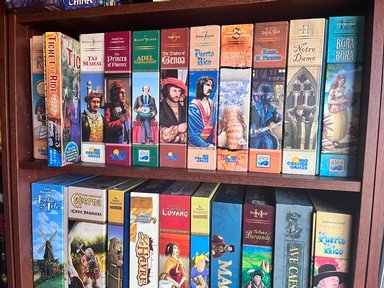Quiz Answer Key and Fun Facts
1. The quintessential game of world domination is, appropriately, played on a world map. Players' army tokens mark the territories they claim; you get more armies for turning in cards or conquering continents. Battles are matters of numbers and chance, pitting the dice of up to two defending armies against the dice of up to three attacking armies until one side is destroyed. What's the name of the game?
2. A world map needn't be the stage for competition and conquest: it could also be the scene of intense cooperation. In one game, players form a team to cope with simultaneous outbreaks of four diseases. They race around the globe to treat patients, build research centers, and develop cures before it's too late for humanity. What game is this?
3. "Empire Builder" was the first in a series of train games in which players get to modify the map directly. As you, a railroad baron, make freight runs and upgrade your train -- all en route to connecting major cities and banking a carload of cash -- how do you mark where you've laid your tracks?
4. Here's a war game played on a map of Europe, across borders drawn roughly as they were at the outset of World War I. Players compete for supply centers, which support their land and sea units -- but the real heart of the game is the negotiation phase, in which players talk each other into alliances and pacts. Their actual orders for the next turn, though, are written down in secret -- so they can't be held to their promises. Which of these games thus continues war by other means?
5. Some knowledge of American geography will be helpful to the aspiring railway magnates of this game. Each player lays one or two lengths of track in a turn, joining up with a rival's line when it seems expedient. The winner is the first to connect all five of the cities she randomly drew at the beginning. What game is this?
6. The map doesn't have to stay the same between games. One popular resource game starts with the construction of a six-sided island from hexagonal tiles -- and the random geography thus generated determines where players should place their initial settlements and roads. Every tile (except the desert) is associated with a number, so its resources can be unlocked with a roll of two dice. What's the name of the game?
7. In a typical game of "Ticket to Ride", the map is quickly populated by colorful plastic tokens, marking the train routes that the players have claimed. Each player earns points according to cards drawn from a stack; what sort of tasks do the cards assign?
8. War sometimes breaks out on the world map of "Sid Meier's Civilization: The Board Game", but it isn't the only way to win: instead, a civilization may focus on science, or the arts, or the economy. What type of work inspired this board game?
9. It's somewhat unusual for the map to change DURING the game, but it can be made to work. In one example, the players are a team of archaeologists, struggling to salvage artifacts from a booby-trapped island. As time passes, parts of the island flood -- and then sink forever beneath the sea. What's the name of the game?
10. One classic war game includes economics in the mix: a player's territories generate Industrial Production Certificates, which can be traded in for new units or for upgrades. "Axis & Allies" takes its name from the cataclysmic war that inspired it; which war was that?
Source: Author
CellarDoor
This quiz was reviewed by FunTrivia editor
WesleyCrusher before going online.
Any errors found in FunTrivia content are routinely corrected through our feedback system.
